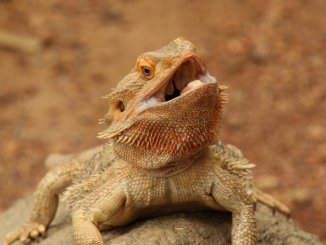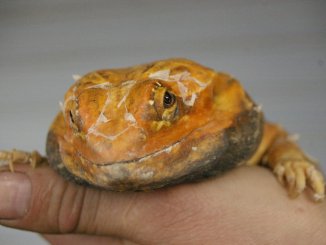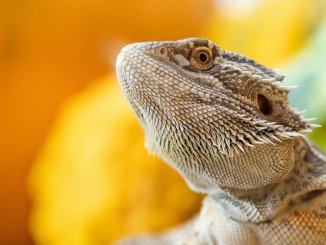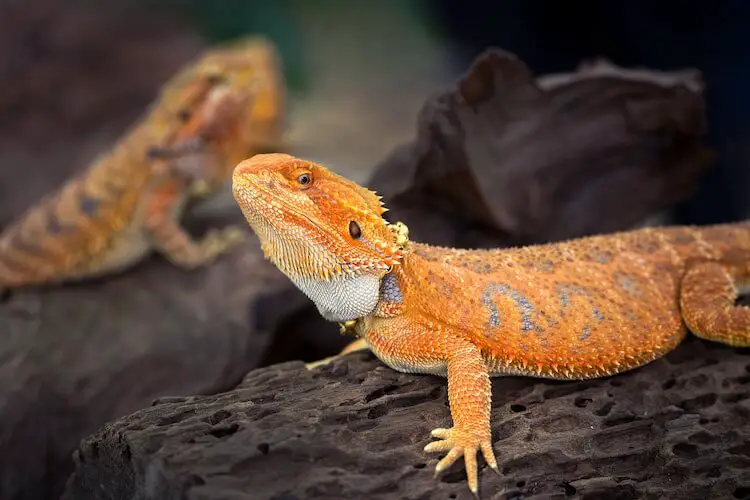
There are many different types of bearded dragons. Regular bearded dragons are called wild types and are the most common. They are very easy to find in pet stores and online.
The other major category is called fancy. Fancy is a term used for morphs or species that are different than the standard wild-type.
Fancy species are selectively bred for brighter colors, unique scale patterns, or larger sizes.
It can be confusing for owners looking to buy a fancy bearded dragon. Most fancies do not look like each other, and there is a big variety of colors, patterns, and prices.
Are you interested in adopting a fancy beardie? Before buying, you should know what exactly makes a bearded dragon fancy. You should also know how to spot one and the differences between them and wild-type species.
What Is A Fancy Bearded Dragon?
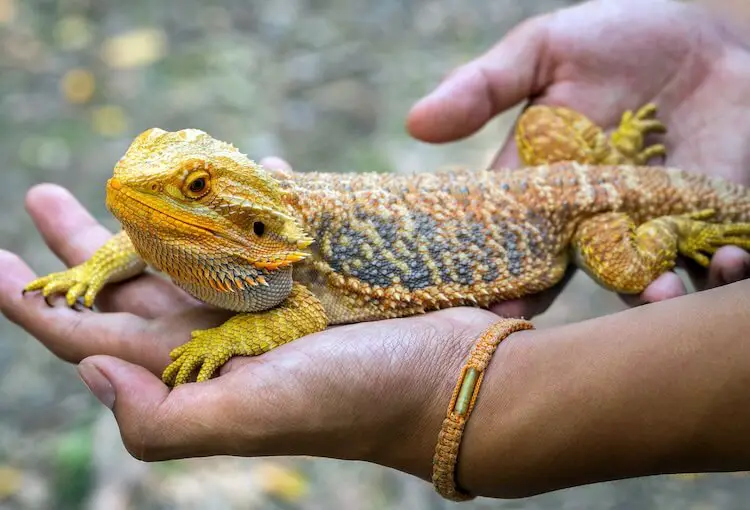
A bearded dragon is called fancy if its color, pattern, or scales fall outside of the normal range of wild-type species. There is no official definition for a fancy bearded dragon. Any individual dragon that has a rare color, pattern or size can be labeled as fancy.
Fancy is not a morph, but a category for every morph and species that is rare or unique.
Regular bearded dragons (Pogona vitticeps) are normally tan, beige, or light brown, with muddy yellow markings. Their color and pattern are adapted for camouflaging in the desert of Australia. Fancy bearded dragons have vivid red and orange colors, striking zigzag patterns and fewer spikes.
These traits make them easy to identify, but it also means it is difficult for them to survive in the wild.
Fancy beardies stand out to predators. For example, a high-red morph sitting on a branch in Australia would be easily spotted by a hawk, whereas a wild type would blend in.
Because of this, fancy bearded dragons are mostly kept as pets. But, where did they come from?
Breeding
Bearded dragons are very easy to mate in captivity.
Selective breeding is a process where two Bearded Dragons with the desired trait are mated to create offspring with the same traits. The offspring are then bred with other offspring, that carry the same trait, to increase the intensity.
Captive selective breeding allows fancy dragons to pass on their unique traits.
Many of these traits start off as natural mutations in normal bearded dragons and gives them a slightly different appearance. Common mutations include brighter colors or fewer spikes.
In wild populations these traits often do not survive because of predators or health issues.
For example, a scaleless fancy bearded dragon is the result of a scale-gene mutation. This mutation reduces the number of scales a bearded dragon has. In the wild this makes them more vulnerable to stuck shed, injury and predators. Because of this, a scaleless fancy has never been found in the wild.
Breeding bearded dragons for fancy traits has its downside.
Some species like the Silkback often have health problems and a shorter lifespan.
When looking to buy a fancy bearded dragon, it is important to know the reputation of the breeder. Healthy species are bright, alert, and active, with strong legs and no retained shed.
Price
Fancy bearded dragons are more desirable than normal dragons.
The appeal of fancy species comes from their interesting, one-of-a-kind colors and patterns.
Fancy bearded dragons are sold for $150 to $300. Some very rare morphs such as the ‘zero’ are sold for over $900. This is much more than wild-type bearded dragons that sell for $30 to $50.
The higher price is because many keepers will pay more for the appeal of having a ‘fancy’ beardie.
Fancy Bearded Dragon vs. Regular Bearded Dragon
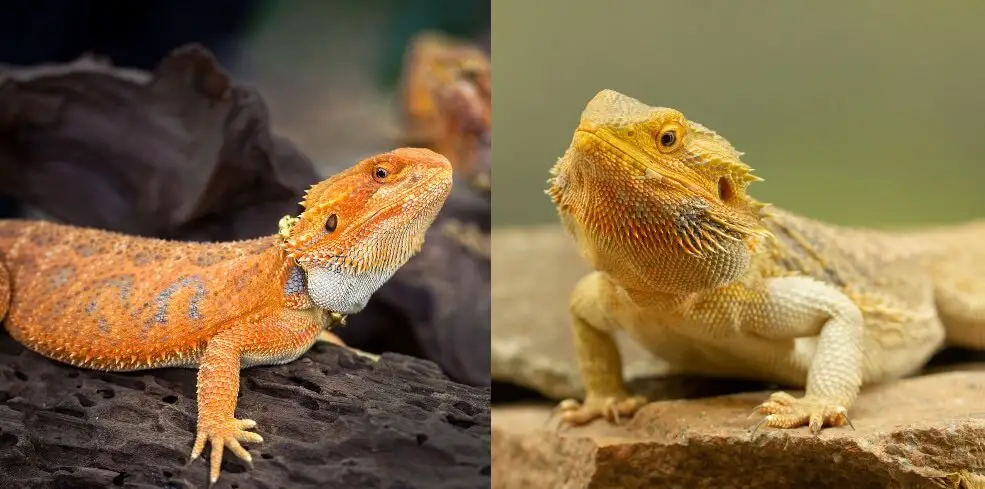
There are eight different species of bearded dragon and four are kept as pets. The central bearded dragon (Pogona vitticeps) is the most popular pet species. Every fancy bearded dragon is from the Pogona vitticeps subspecies. But, they have been selectively bred to express rare colors and patterns.
Both fancy and common bearded dragons are the same subspecies, but they have different colors, markings, and size:
| Fancy | Wild Type | |
|---|---|---|
| Appearance | Fewer or no scales and unusual markings and patterns like spots, stripes, and zigzags | Rough and spiny, light stripe down the spine with stripe-like irregular blotches on the sides |
| Color | Bright yellow, black, orange, red, and purple. Also includes albino and melanistic varieties | Sandy, tan, or light brown with beige and white markings |
Appearance
Most fancy bearded dragons are similar in size to regular bearded dragons, apart from one famous exception. Wild-type bearded dragons grow to reach 15 to 20 inches long. The German Giant morph can grow to be 30 inches long!
Spikes
Some fancy bearded dragons are very different from common beardies. The most famous are the leatherback and silkback morphs.
Leatherback dragons have very few spines on their beards, sides, and backs, very tiny scales, and a smoother texture. Silkback morphs have no spines or scales and have a smooth wrinkly texture.
Color
Fancy bearded dragons are specifically bred to be vivid and bright. Common dragons are tan, brown, and white, with sandy hues and a light yellow overtone. Most fancy beardies are red and orange, with white, black, and even purple markings.
Pattern
Another difference between common and fancy bearded dragons is their pattern. Wild-type dragons have a light stripe along their spine with darker, irregular blotches on either side. Popular patterns include tiger stripes, zigzags and camouflage print.
Diet
The diet of a fancy bearded dragon is the same as a wild type. Both lizards are omnivores that eat a mix of fruits, vegetables and insects. As they age, bearded dragons change the proportions of their diet from mostly insects to mostly vegetables.
Behavior
Fancy bearded dragons are no different from common species in terms of their behavior. They are naturally friendly and easy to tame. Both types are known to head bob, dig, gape, wave, hiss and stamp.
Care
Fancy bearded dragons look very different from wild-type Beardies, but nearly all of them need the same care. Most have identical temperature, humidity and lighting needs. However, silkback and leatherback morphs are more sensitive to light and sharp objects so they require special care.
How To Identify A Fancy Bearded Dragon
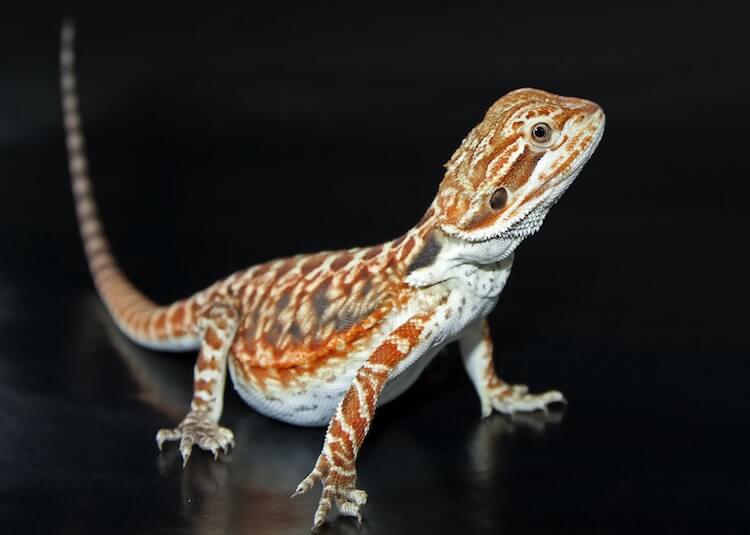
Many pet shops like to advertise their rare and exotic pets as fancy in the hope it will increase the appeal and interest from buyers.
Just because your bearded dragon is labeled as fancy does not mean that it is. The opposite is also true. A beardie may mistakenly be labeled as common when it is fancy!
The term ‘fancy’ is not an official description.
So, how can you determine if a bearded dragon is common or fancy?
The easiest way to spot a fancy is to look at their color or pattern. These are the determining factors.
Fancy bearded dragons typically have bright red, orange, and yellow stripes down their backs. Blacks, browns and whites are also common in fancy species. Any of these colors can be presented in stripes, spots, zigzags and even figure-eight patterns. It depends on the morph and its genetic background.
Wild bearded dragons normally do not have vivid patterns or colors and are more natural, sandy hues.
Silkback and leatherback dragons are the easiest fancy dragons to identify. They are born with few to no scales and spines, giving them a wrinkly appearance and a silky skin texture.
Yellow, green, red and ruby red bearded dragons are also easy to spot because of their bright color.
Common Bearded Dragon
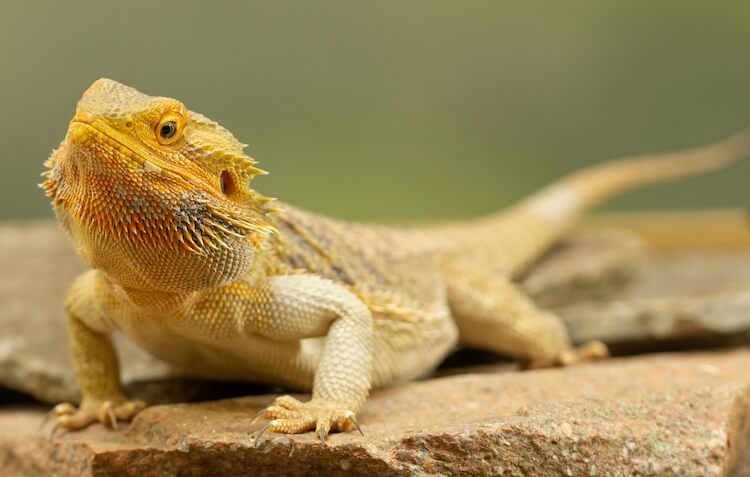
If your bearded dragon has unusually vibrant reds, fiery oranges, or noticeable browns and blacks, the chances are that it is fancy! If you have read our guide, and think you may have actually purchased a regular bearded dragon, then our list below can help. Below are four ways to identify a common or wild type:
Color
Common bearded dragons are perfectly colored to blend in with their habitat. They are tan or brown, with mottled dark and light patches along their sides and horizontal stripes on their tail. Most have a dark stripe that runs through their eye and down to their ears.
Body
Regular bearded dragons have a single row of soft spines running down each side of their body. The largest spine is nearest the front arms. These spines emphasize their flat pancake-shaped body, especially when they are basking.
Head
Wild types have wide, triangular heads that are fringed by two rows of spines. Their heads are large in comparison to their body size.
Beard
Their famous ‘beard’ is the feature that gives bearded dragons their name. It is a spine-covered pouch under their chin that can be inflated and darkened. During the breeding season, males will inflate their beards and bob their heads to compete for mates or show dominance.
Summary
Fancy is a category of bearded dragon that includes every morph and species that is rare or unique.
These dragons are similar to bearded dragons. They have just been selectively bred for specific traits like bright and vivid colors or unique patterns. This makes them brighter and more colorful than their common cousins.
Fancy bearded dragons often have striking, bold patterns that look like zebra stripes or polka dots.
These unique markings come in bright reds, yellows, oranges, blacks, and even purples. These colors are not found in wild-type species.
Their color and price tag make fancy bearded dragons stand out in a crowd. But, their care, diet, and behavior are exactly the same as common bearded dragons.
Ready to add a fancy dragon to your reptile collection? Let us know in the comments.

